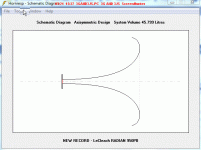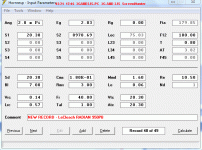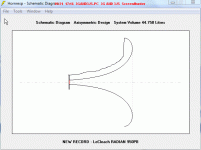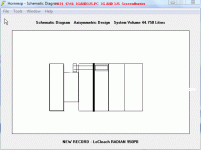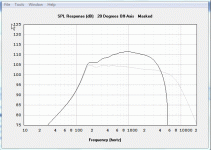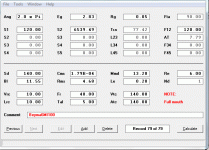View attachment 215092
View attachment 215093
Since I have Chosen the RAdian driver and I a crossing at 300Hz I probably dont need a 130hz horn.
Here is 180hz LeCleach horn. It will be roughly 90cm long and 90cm in diameter.
You forgot to add T. Standard value is T=0,8. Length will now be 75cm and diameter 107cm!
This is a preliminary measurement of the 200Hz Auto-Tech LeCleach horns(L=65cm, D=100cm) we just received. There is now idea whatsoever to build them ourselves as that would be more costly.

Note the 2441 below the horn😉.

These or a pair of 180Hz horns need to be c/o at 3-4kHz.
But you still need a pair of midbass horns below 300-400Hz.

Note the 2441 below the horn😉.
These or a pair of 180Hz horns need to be c/o at 3-4kHz.
But you still need a pair of midbass horns below 300-400Hz.
Cool. I am think of a variation of the Vitavox Bassbin for sub 300Hz.
I will be using a smaller LeCleach horn with a Tad2001, S2 or Yammy 6681 for the 3k to 10K range.
If anyone wishes to start modelling a Vitavox bassbin feel free 🙂
I will be using a smaller LeCleach horn with a Tad2001, S2 or Yammy 6681 for the 3k to 10K range.
If anyone wishes to start modelling a Vitavox bassbin feel free 🙂
If anyone wishes to start modelling a Vitavox bassbin feel free 🙂
You can easily do a quickie yourself. Go for something like Exp, Am=16000cm2, At=1800cm2 and L=1500cm. Try with two 515-8G.
Is it acceptable for the horn flare to drop down in a straight vertcal line (taken fron the last point given from hornresp). I have seen some where the curve is continued around (as in the picture posted above). My horn will be 50mm thick plywood and this should look nice and be simpleto build.
I assume this is purely aesthetics. I am making the template for the 180hz LeCleac'h.
I assume this is purely aesthetics. I am making the template for the 180hz LeCleac'h.
Here is a very poor sketch of what I meant, I will give it a nice round edge.
My lower midrange horn has also a more pronounced edge, towards LeCleac'h profile, its something between regular tractrix, and LeCleac'h. I don't think such big lips as zagaja did, brings a considerable advantage. Neither do i like it aesthetically. And you will be obliged to set the acoustic centers of the other channels more far away. Making a 4" throat, and a adapter for 2" is however clever, so you can play, and try paper cones out.
You will also need to think how you will attach the horn to the frame. May you make a part of the outer section straight, or square.

Last edited:
I have experimented a bit and if i return the edge with a curve of approx. half the radius of the outer flare it looks right to me. I will make one of the joints at the 4" point to fascilitate 8" drivers.
The 50mm wall thickness will allow me to put a rebate in the outer edge to allow a bolt to hold the 4"/2" adapter in and also the driver.
The 50mm wall thickness will allow me to put a rebate in the outer edge to allow a bolt to hold the 4"/2" adapter in and also the driver.
Attachments
Last edited:
Hi 3GGG,
Sim your horn with the 85-90 degrees above and compare with your 180 degrees. You will the see it will be a considerable difference. For mid and high the full 180 degree is essential. If you use Jean-Michells spreadsheet you will also get the figures beyond 180 degrees.
In the case of low-mid the effect will not be as important as such a horn will be helped by mirroring from the floor. I wouldn´t go over 90 degrees for low-mid either.
Sim your horn with the 85-90 degrees above and compare with your 180 degrees. You will the see it will be a considerable difference. For mid and high the full 180 degree is essential. If you use Jean-Michells spreadsheet you will also get the figures beyond 180 degrees.
In the case of low-mid the effect will not be as important as such a horn will be helped by mirroring from the floor. I wouldn´t go over 90 degrees for low-mid either.
Hi Lars
How do I sim the 90 Degrees? Can I do that in Hornresp?
I would like to do so, especially for the proposed 350hz horn for the next channel up.
Gregg
How do I sim the 90 Degrees? Can I do that in Hornresp?
I would like to do so, especially for the proposed 350hz horn for the next channel up.
Gregg
post68.
The 180degree return looks good. It should be possible to make a template from Hornresp that gives the shape you need.
If you retain a bit more material on the back of the mouth, you can extend the return to 270degrees where it meets the outside of the horn outer thickness. this could be pretty close to a full Lecleach.
The 180degree return looks good. It should be possible to make a template from Hornresp that gives the shape you need.
If you retain a bit more material on the back of the mouth, you can extend the return to 270degrees where it meets the outside of the horn outer thickness. this could be pretty close to a full Lecleach.
Hey Gregg,
Could this be something for you:
http://www.diyaudio.com/forums/multi-way/140190-jean-michel-lecleach-horns-10.html#post1781991
Could this be something for you:
http://www.diyaudio.com/forums/multi-way/140190-jean-michel-lecleach-horns-10.html#post1781991
links to webpages with pictures and descriptions of Audio Systems with hornspeakers - Page 37 - Audio Voice Acoustics
Visited CV tonight and we listened to the Azura 160s with both S2 and RCA MI-1443. S2 crossed at about 300Hz and RCA at about 250, I think. Ok, it was one mono channel, with just the horn and a Fostex tweeter (the expensive one with magnesium diaphragm).
What we listened to was rather rough and ready, but has reinforced by conviction that using a compression driver down to 300Hz, or even 200Hz is absolutely desirable. The 300Hz - 1kHz contains so much fundamental musical information, thaty getting this right is extremely important to reproducing music.
The S2 is nice and it's definitely works using it down low like that, but may not be the best choice. In isolation it sounded very good used like that. The RCA on the other hand is a completely different kettle of fish. Absolutely astonishing. I don't think I have heard Cello reproduced in such a lifelike manner. Piano is notoriously hard to reproduce with realistic scale and presence. Truly, despite the limitations of the thrown togtherness, this showed such promise that you soon realise that conventional speakers are never going to compete.
JJ - this has convinced me it's defnitely worthwhile going down the compression driver/big lower mid horn.
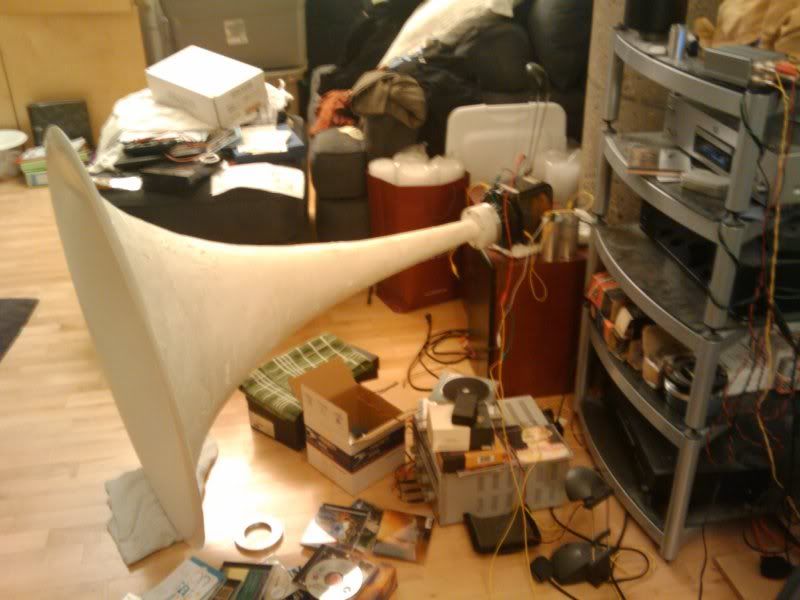
Visited CV tonight and we listened to the Azura 160s with both S2 and RCA MI-1443. S2 crossed at about 300Hz and RCA at about 250, I think. Ok, it was one mono channel, with just the horn and a Fostex tweeter (the expensive one with magnesium diaphragm).
What we listened to was rather rough and ready, but has reinforced by conviction that using a compression driver down to 300Hz, or even 200Hz is absolutely desirable. The 300Hz - 1kHz contains so much fundamental musical information, thaty getting this right is extremely important to reproducing music.
The S2 is nice and it's definitely works using it down low like that, but may not be the best choice. In isolation it sounded very good used like that. The RCA on the other hand is a completely different kettle of fish. Absolutely astonishing. I don't think I have heard Cello reproduced in such a lifelike manner. Piano is notoriously hard to reproduce with realistic scale and presence. Truly, despite the limitations of the thrown togtherness, this showed such promise that you soon realise that conventional speakers are never going to compete.
JJ - this has convinced me it's defnitely worthwhile going down the compression driver/big lower mid horn.

Hardly a Mmd of 0,44gram! In fact none of the parameters seems to be right. Have you made Hornresp do the calculation?
- Status
- Not open for further replies.
- Home
- Loudspeakers
- Multi-Way
- Best 8" to 12" driver for 130hz tractrix horn
